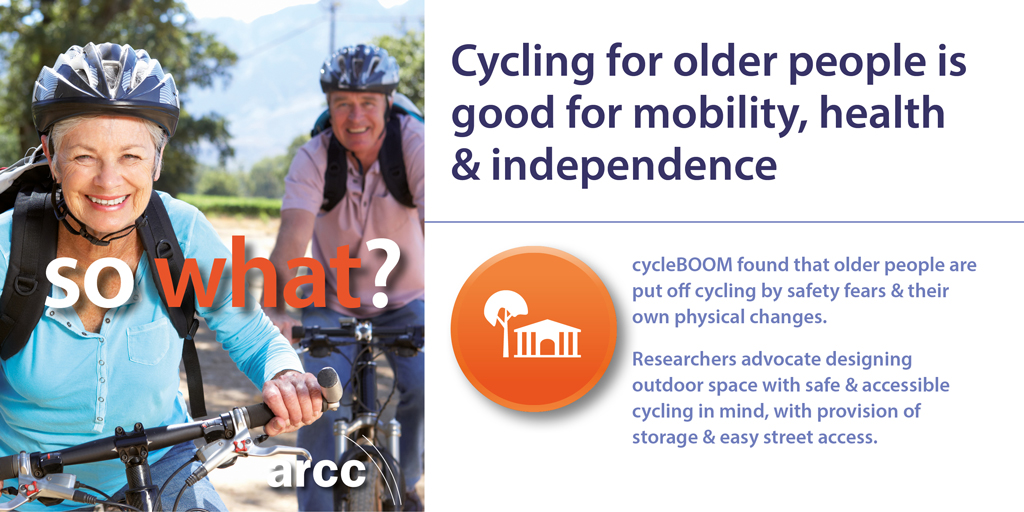Older people make up an increasing proportion of Europe’s population: the cycle BOOM study focused on how cycling can affect the mobility, health and wellbeing of the older population.
Policymakers are looking for ways to support and encourage people to stay active for longer in an effort to reduce morbidity and the wider impact on national health and care services. Mobility and independence allow older people to engage in meaningful activities outside their home, helping to foster social engagement and a sense of belonging in the world. In the UK, cycling is relatively rare among the older population. The cycle BOOM study sought to better understand how the design of the built environment, technology and other social and biological factors shape cycling as people get older. Cycle BOOM was led by Oxford Brookes University in association with University of Reading, University of the West of England and Cardiff University.
Relevance
Cycling is a well-used form of transport for older people in northern Europe, with 23% of journeys made by cycle in the Netherlands, 15% in Denmark and 9% in Germany. However, in the UK, only 1% of older people’s journeys are currently made by cycle.
The concept of ‘older mobility’ in the UK remains narrow. Cycling is not considered to be something older people are capable of, or want to do. As a result, there is a lack of consideration for the potential benefits of cycling for older people, and little guidance on how the environment and technology could be adapted to support their cycling needs.
The cycle BOOM study provides evidence and recommendations on ways to develop cycling as part of an age-friendly cities agenda.
Rationale
- Currently there are low levels of older people cycling in the UK compared to the rest of northern Europe.
- There is great potential to increase cycling rates.
- We urgently need to act to develop the infrastructure and support required for an ageing society.
Now what
A major shift in culture is needed to plan for older mobility. Whilst cycling offers a potentially positive experience for older people through engaging with landscape, social contact and physical exercise, it is widely regarded as dangerous. As a result, the majority of the older population is therefore reluctant to cycle.
cycle BOOM found that despite the many benefits of cycling, the older population is generally reluctant to cycle due to fears about safety, increasing difficulties as their body ages, an unsupportive built environment and technology that is ill adapted to their needs.
However, there is the potential to engage a significant number of older people in cycling as part of an individually focused approach for healthy ageing. The availability of power-assisted cycles (e-bikes) was also found to provide health and wellbeing benefits on a par with pedal cycles. We need to do much more to capitalise on the potential of cycling for older people.
Relevance
cycle BOOM found that planning for older mobility requires a major cultural shift, changing approaches and policy across different sectors, and partnership working at all levels.
Implementing an age-friendly cities agenda
The Age Friendly Cities agenda provides a practical framework to support and promote cycling.
cycle BOOM makes recommendations for all eight of the Age Friendly City domains, including the need to:
- recognise the full potential of cycling for health and wellbeing, and as a mobility tool for older people
- design outdoor space to offer a safe, comfortable, convenient and enjoyable experience for cycling
- provide secure and convenient cycle storage and street access, and to ‘think beyond the building’ to improve access to neighbourhood services by cycle.
Findings
- Multiple potential benefits to mobility, health and wellbeing for older cyclists.
- Cycling is currently viewed as dangerous by older people.
- Improvements to enable cycling by older people benefit pedestrians, drivers and other cyclists of different ages and abilities.
Taking action
- Electrically assisted bicycles can prolong and re-engage older people with cycling, and have similar benefits to pedal cycles.
- Partnership working at all levels is needed to make cycling safer through infrastructure and traffic management.a
- Promotion and support for cycling through activities, events and programmes is also required.


